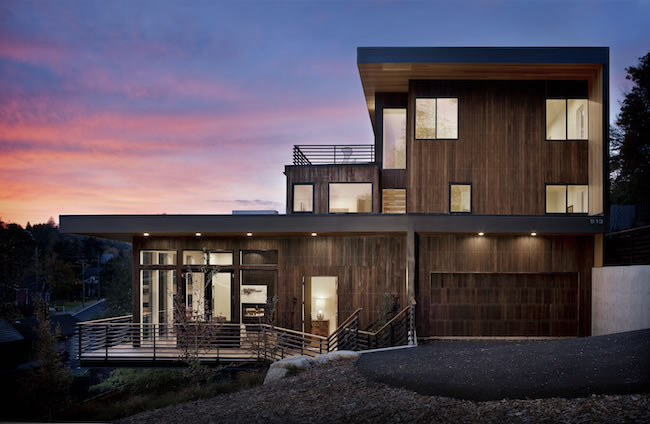Situated on a steeply sloped lot in the Madison Park neighborhood of Seattle, a 3,200-square-foot custom-spec house by First Lamp was designed to grow out of the hillside with a main living space that floats out among the trees. The house will be an Energy Star-certified residence and is targeted to be 4-star Built Green. Here’s a look at how the designers did it.
A SECURE FOUNDATION
The site’s steep topography, lack of strong vegetation, layout of surrounding properties, and history of landslides all contributed to some serious vulnerabilities. “It was an exercise in logistics,” says project manager and lead designer Kevin Witt of First Lamp. As a result, a lot of the design has to do with the foundation. The house sits on 54 four-foot-diameter pin piles driven into the earth at least 20 feet deep, while five helical anchors (“picture gigantic wood screws,” says Witt) at a 20-degree angle anchor the house into the hillside and keep it from sliding down—all combined with a concrete foundation that retains the uphill side of the slope as well.
PROJECT
LOCATION Seattle, WA
Size 2,819 ft2
Completion 2014 Certification 4-Star Built-Green (Pending)
Program Single-Family Residence
Cost $900,000
TEAM
OWNER Square Two
Developer Square Two
Architect First Lamp
Civil Engineer Decker Consulting Engineers
Structural Engineer Année Structural Engineering
General Contractor Folded Line
SUPPLIERS
Glass Systems Jeld-Wen Rainscreen Pacific Exteriors Air/Weather Barrier Apex Specialty Coatings
Roofing America 1st
Lighting Lightology.com
HVAC Northwood Heating
DESIGNED TO LAST
Witt and his team at First Lamp take a building science approach to how buildings are put together, and spent a lot of time on this project thinking about water vapor and how walls work across inside/outside thermal gradients. As a result, the entire project has an open-joint rainscreen and a liquid-applied air barrier underneath. “The liquid barrier makes it easier to air seal and the rainscreen makes the siding last longer—plus there’s a thermal advantage,” Witt says. “The reality is a rainscreen system helps walls breathe better so we just sleep better at night knowing everything is going to last longer.”

The interior features durable bamboo floors, a wood with a Janka rating as high as some of the Brazilian hardwoods.
ENDURING MATERIALS
The siding is almost 100% cedar, charred to more closely reflect the deep ambient color under a grove of mature trees. As one of the more resistant woods out there, cedar stands up to the elements and the deep charred finish gives it even more weather-and decay-resistance and durability. The interior features durable bamboo floors, a wood with a Janka rating as high as some of the Brazilian hardwoods. “We used mainstream materials,” Witt says, “but we turned the volume up on them.”
LIVING ROOF
The house is topped with approximately 2,000 square feet of living roof, which acts not only as a filter and a sponge, but an aesthetic amenity for the homeowners as well. “City engineers prefer to have all stormwater seep into the soil so they don’t have to treat it at a plant,” Witt says. “Our geotechnical engineer wanted to get as much of the stormwater off site as possible, though, so the green roof was the perfect solution.” Not only is maintenance relatively low (re-seeding is easy, according to Witt), a green roof prolongs the life of waterproofing membranes by protecting them from UV rays that can break them down.



